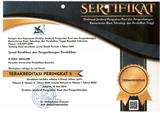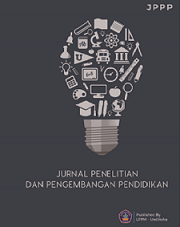A Study of the Instructional Media Used by the English Teachers in Teaching English
DOI:
https://doi.org/10.23887/jppp.v4i3.27095Keywords:
instructional media, teaching English, the implementationAbstract
This study was a descriptive qualitative which intended to investigate the types of instructional media used and the implementation done by the English teachers. The instructional media used to become the best solution to overcome the learning problems faced by the teachers. The subjects of this study were 5 English teachers at SMPN 2 Melaya. The data were collected through observation during the teaching and learning process and interviews with the teachers. The data analyzed descriptively. From the overall findings, the English teachers used eight types of instructional media, such as; real objects or models, slides, pictures, video, web, audio, books, and the boards. The teachers had different ways to implement them, such as they used LCD Projector and speakers as the tools to show the material and the school environment as the realia. The lack of facilities became the main problem in implementing them. Moreover, the teachers tend to use the same instructional media for the other topic since they do not have enough time to prepare.
References
Adegbia, M. V. & Fakomogbon, M. A. (2012). Instructional media in teaching and learning: A Nigerian Perspective. Global Media Journal, 6(2), 216-230.
Aini, W. N. (2013). Instructional media in teaching English to young learners: A case study in elementary school in Kuningan. Journal of English and Education, 1(1), 196-205.
Ali, M. (2009). Pengembangan media pembelaaran interaktif mata kuliah medan elektromagnetik. Jurnal Pendidikan teknik Elektro FT UNY, 5(1).
Astrini, N. F, Ratminingsih, N. M, Utami I. G. A. L. P. (2020). The model of strategies employed by English teachers in teaching writing skill in National Plus Schools. Journal of Education Research and Evaluation, 4(1), 59-62.
Arsyad, A. 2009. Media pembelajaran. Jakarta: Rajawali Pers.
Arsyad, A. 2013. Media pembelajaran. Jakarta: Rajawali Pers.
Brown, H. D (2001). Teaching by principles: An Interactive Approach to Language Pedagogy. Englewood Cliffs: Prentice Hall.
Cameron, L. (2001). Teaching languages to young learners. Cambridge: Cambridge University Press.
Chamunorwa, J.(2010). Discussion Method of Teaching and Learning. Retrieved from http://zvavanhuchopper.blogspot.com/2010/10/discussion-method-of-teaching-and.html
Denzin, N. K., & Lincoln, Y. S .(1994). Introduction: Entering the field of qualitative study. Thousand Oaks, Sage Publications.
Derakhshan, A. (2015). The difficulties of teaching English language: the relationship between research and teaching. International Journal of Linguistics, 7(1), 102-110.
Dewi, P. A. K, Ratminingsih, N. M, Santosa, M, H. (2020). Mobile-assisted task-based language learning, writing competency, and motivation. Jurnal Pendidikan Indonesia, 9(1), 119-130.
Fatimah, A. S. (2017). Teaching in 21st century: students-teachers’ perception of technology use in the classroom. Journal of Linguistic and English Teaching, 2(2).
Gushendra, R. (2017). An experimental study: improving students’ vocabulary mastery by using English song. Indonesian Journal of Integrated English Language Teaching, 3(1), 53-63.
Harmer, J. (2007). The Practice of English Language Teaching. New York: Longman Inc.
Heinich, R. Molenda, M. Russell, J.D, & Scnaldino, S.E. (1996). Intructional and the New Tecnologies of Instruction. New York: Macmillan.
Hestiningsih, W. & Maili, S. N. Masalah-masalah pembelajaran Bahasa Inggris pada Sekolah dasar. Media Penelitian Pendidikan, 11(2), 54-62.
Lee. A. Y. (2016). Media education in the School 2.0 era: Teaching media literacy through laptop computers and iPads. Journal of Global Media and China, 1(4), 435-449.
Lim. F. P. (2019). An analysis of synchronous and asynchronous communication tools in e-learning. Advanced Science and Technology Letters, 143(46), 230-234.
Mahajan, G. (2012). Multimedia in Teacher Education: Perceptions and Uses. Journal of Education and Practice, 3(1), 5-12.
Mateer, G. D., Ghent, L. S., Porter, T., & Purdom, R. (2018). Using Media to Enhance Teaching and Learning. Action the SERC Portal for Educators: https://serc.carleton.edu/sp/library/media/index.html
Maili, S., N. & Hestiningsih, W. (2016). Masalah-masalah pembelajaran Bahasa Inggris pada Sekolah Dasar. Media Penelitian Pendidikan, 11(2), 54-62.
Miles, M. B., & Huberman, A. M. (1994). Qualitative data analysis (2nd ed). London: New Delhi
Mohan,. S. (2013). Instructional media for effective language teaching. International Journal of Humanities, Arts, Medicine and Science. 1(3), 81-84.
Ogbonna, C. G., Ibzeim, N. E., Obi, C. A. (2019). Synchronous versus asynchronous e-learning in teaching word processing experimental approach. South African Journal of Education, 39(2), 1-15.
Onyia & Mary, N. (2013). Instructional materials and design: issues and challenges. Academic Journal of Interdisciplinary Studies, 2(6), 153-158.
Rahmi, R. (2014). The implementation of media in English language teaching. STKIP Bina Bangsa Getsempena Banda Aceh, 5(1), 1-16.
Ratminingsih. N. M. (2016). Efektifitas media audio pembelajaran Bahasa berbasis lagu kreasi di kelas lima Sekolah Dasar. Jurnal Pendidikan Indonesia, 5(1), 27-38.
Ratminingsih, N. M., & Budasi, I. G. (2012). Pelatihan pemanfaatan lagu-lagu kreasi khusus (scripted songs) dalam pembelajaran bahasa Inggris berbasis tema di sekolah dasar di Kecamatan Sukasada Kabupaten Buleleng. Laporan P2M. Universitas Pendidikan Ganesha.
Ratminingsih, N. M, Mahadewi, L. P. P, Divayana, D. G. H. (2018). ICT-Based interactive game in TEYL: teachers’ perception, students’ motivation, and achievement. International Journal of Emerging Technologies in Learning, 13(9), 190-203.
Reiser, R. A., & Dick, W. (1995). Instructional Planning: A guide for teachers (2nd ed).
Rodgers, D. L. (2005). The effect of instructional media on learner motivation. International Journal of Instructional Media, 32(4), 333-342.
Rokhayani, A. & Utari, A. R. P (2014). The use of comic strips as an English teaching media for Junior High School students. Language Circle Journal of Language and Literature, 8(2), 143-149.
Sadiman, A., Sudjarwo, S., & Radikun. (1986). Media pendidikan: pengertian, pengembangan, dan pemanfaatannya (6th ed). Jakarta: CV Rajawali.
Sukmahidayanti, T. (2015). The utilization of instructional media in teaching English to young learners. Journal of English and Education, 3(2), 90-100.
Songbatumis, A. M. (2017). Challenges in teaching Enlish face by English teachers at MTsN Taliwang, Indonesia. Journal of foreign language teaching and learning, 2(2), 54-67.
Tamrin, M., Azkiya, Hidayati. & Sari, S. G. (2017). Problems faced by the teacher in maximizing the use of learning media in Padang. Al-Ta’lim Journal, 24(1), 60-66.
Yassaei, S. (2012). Using original video and sound effect to teach English. English Teaching Forum, 1, 12-16.
Downloads
Published
How to Cite
Issue
Section
License
Authors who publish with the Jurnal Penelitian dan Pengembangan Pendidikan agree to the following terms:
- Authors retain copyright and grant the journal the right of first publication with the work simultaneously licensed under a Creative Commons Attribution License (CC BY-SA 4.0) that allows others to share the work with an acknowledgment of the work's authorship and initial publication in this journal.
- Authors are able to enter into separate, additional contractual arrangements for the non-exclusive distribution of the journal's published version of the work (e.g., post it to an institutional repository or publish it in a book), with an acknowledgment of its initial publication in this journal.
- Authors are permitted and encouraged to post their work online (e.g., in institutional repositories or on their website) prior to and during the submission process, as it can lead to productive exchanges, as well as earlier and greater citation of published work. (See The Effect of Open Access)







